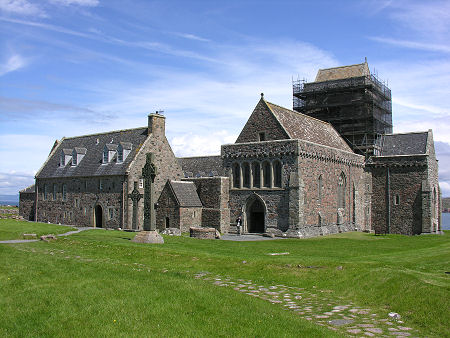|
SCOTLAND
As a result of its geography, Scotland has two different societies. In the centre of Scotland mountains strech to the far north and across to the west, beyond which lie many islands. To the east and to the south the lowland hills are gentler, and much of the countryside is like England, rich, welcoming and easy to farm. North of the “Highland line”, as the division between highland and lowland is called, people stayed tied to their own family groups. South and east of this line society was more easily influenced by the changes taking place in England.
Scotland was populated by four separate groups of people. The main group, the Picts, lived mostly in the north and northeast. They spoke Celtic as well as another, probably older, language completely unconnected with any known language today, and they seem to have been the earliest inhabitants of the land. The Picts were different from the Celts because they inherited their rights, their names and property from their mothers, not from their fathers.
The non-Pictish inhabitants were mainly Scots. The Scots were Celtic settlers who had started to move into the western Highlands from Ireland in the fourth century. In 843 the Pictish and Scottish kingdoms were united under a Scottish king, who coul also probably claim the Pictish throne through his mother, in this way obeying both Scottish and Pictish rules of kingship.
The third group were the Britons, who inhabited the Lowlands, and had been part of the Romano-British world. They had probably given up their old tribal way of life by the sixth century. Finally, there were the Angles from Northumbria who had pushed northwards into the Scottish Lowlands.
Unity between Picts, Scots and Britons was achieved for several reasons. They all shared a common Celtic culture, language and background. Their economy mainly depended on keeping animals. These animals were owned by the tribe as a whole, and for this reason land was also held by tribes, not by individual people. The common economic system increased their feeling of belonging to the same kind of society and the feeling of difference from the agricultural Lowlands. The sense of common culture may have been increased by marriage alliances between tribes. This idea of common landholding remained strong until the tribes of Scotland, called “clans”, collapsed in the eighteenth century.
The spread of Celtic Christianity also helped to unite the people. The first Christian mission to Scotland had come to southwest Scotland in about AD 400. later, in 563, Columba, an Irish missionary monk also known as the “Dove of the Church”, came from Ireland. Through his work both Highland Scots and Picts were brought to Christianity. He even, so it is said, defeated a monster in Loch Ness, the first mention of this famous creature.
The Angles were very different from the Celts. They had arrived in Britain in family groups, but they soon began to accept authority from people outside their own family. This was partly due to their way of life. Although they kept some animals, they spent more time growing crops. This meant that land was held by individual people, each man working in his own field. Land was distributed for farming by the local lord. This system encouraged the Angles of Scotland to develop a non-tribal system of control, as the people of England further south were doing. This increased their feeling of difference form the Celtic tribal Highlanders further north.
Foreign invaders increased the speed of political change. Vikings attacked the coastal areas and, in order to resist them, Picts and Scots fought together against the enemy raiders and settlers. When they could not push them out of the coastal areas and the islands, they had to deal with them politically. At first the Vikings, or “Norsemen”, still served the king of Norway. But communications with Norway were difficult, so they slowly found it easier to accept the king of Scots as their overlord, rather than the more distant king of Norway.
However, the English were a greater danger than the Vikings. In 934 the Scots were seriously defeated by a Wessex army pushing northwards. The Scots decided to seek friendship of the English. England was obviously stronger than Scotland but, luckily for the Scots, both the north of England and Scotland were difficult to control from London. The Scots hoped that if they were reasonably peaceful the Sassenachs, as they called the Saxons (and still call the English), would leave them alone.
Scotland remained a difficult country to rule even from its capital, Edinburgh. Anyone looking at a map of Scotland can immediately see that control of the Highlands and islands was a great problem. Travel was often impossible in winter, and slow and difficult in summer. It was easy for a clan chief or noble to throw off the rule of the king.

Iona, the western Scottish island on which St Columba established his abbey in AD 563 when he came from Ireland. From Iona, Columba sent his missionaries to bring Christianity to the Scots. The present Cathedral was built in about 1500.
 14/30
14/30

|